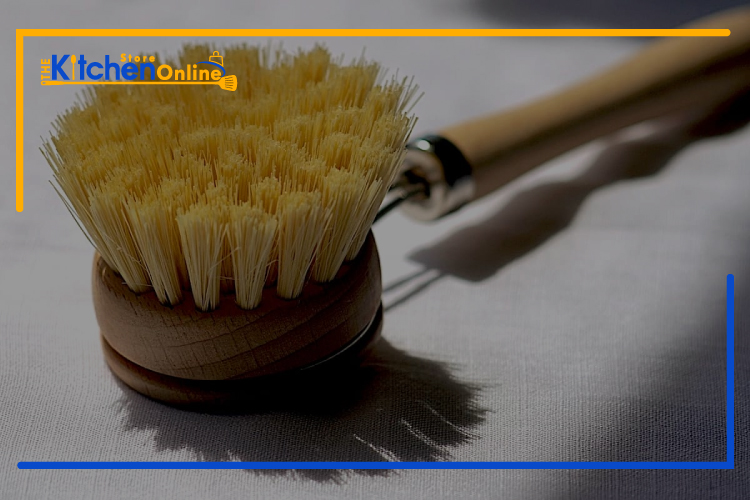Sanitization is very important. And this is especially true when you’re cooking or anywhere near the kitchen. A lot of people don’t quite know exactly how to clean their tools, utensils, and dishes. Brushes can be the more difficult ones.
This guide will teach you how to clean vegetable brushes using vinegar and dishwashing liquid solution. The steps are pretty simple. All you need to be careful about is to let the brush dry in a clean place and make sure all food particles are removed before you start cleaning.
You can also use a dishwasher, but not everyone will have that option. Especially if the handle of your brush is made from wood, but before we dive into how to clean the brush, let’s see if you really need to clean it that often in the first place.
Do You Need to Clean Vegetable Brushes?
Vegetable brushes can be used for different things. You can, of course, use them to clean vegetables but also clean dishes as well. However, the primary use is cleaning vegetables, especially the ones whose roots need cleaning.
Some vegetables can have a lot of dirt on them, and it’s mandatory to give them a good scrub before you cook them. This will make your vegetable brushes dirty. Leaving your brush like that isn’t a good idea at all.
It may accumulate bacteria over time and just doesn’t look appealing. Many people simply rinse the brush under water and call it a day. While that’s fine to do once or twice, to get a clean brush, you need to properly clean it.
Although these brushes are better than cloth and sponges when it comes to bacteria build-up, they do still need some cleaning.
Moreover, the bristles will easily shed moisture. The chances of them harboring bacteria are quite low.
But that doesn’t mean you shouldn’t clean them. We feel like anything that comes in contact with raw food needs to be clean regardless of whether it can harbor bacteria or not.
The last thing you want is to clean your vegetables with a brush that’s dirty in the first place.
How to Clean Vegetable Brushes?
So how do you clean them then? One quick and easy way to clean them is to just toss the brush in the dishwasher. Many Vegetable brushes are dishwasher safe.
Since they are generally easy to clean and maintain, tossing them in the dishwasher also saves you the trouble of manually cleaning them.
One thing to remember is if you use a dishwasher, set it to the heated wash setting. Warm water will do a better job of cleaning than cold water. But what do you do if you don’t have a dishwasher? Or better yet, if the handle is made of wood.
With a wooden-handled brush, putting it in the dishwasher can ruin it quickly. Then there is the chance of them retaining some of the soapy smell as well.
The easiest and most effective way is to clean it with vinegar. Distilled vinegar works best for this.
Here are the steps you need to follow:
Step 1 – Prep the Brush for Cleaning
Before you even put the brush in for cleaning, make sure it’s prepped. What we mean by this is to take out any possible chunks of food or vegetables from between the bristles.
You can hold the brush under warm running water. This will loosen those food particles and make them easier to prep. If you notice some chunks are still there, take a fork and pick at them gently. Be careful though. You don’t want to damage the bristles.
Step 2 – Mix 1 Cup Distilled Vinegar with a Drop of Dish Soap
The next step is to mix 1 cup of distilled vinegar with a small drop of dishwashing liquid or soap. This solution is a really effective way to get any contaminants out of the brush.
Start by pouring the vinegar into a dishpan. Then add a small amount of washing liquid.
Step 3 – Place the Brush in the Solution and Swirl
With the bristle side faced down, place your brush inside the pan where you mixed the solution and give it a good swirl. This will help mix the vinegar and washing liquid.
Step 4 – Let the Brush Soak in the Solution
Now, just let your brush soak in this solution. The minimum we would recommend is to soak it for at least an hour. But if you think you need more time, then go for it. After you have done that, take the brush out of the solution and rinse thoroughly.
This part is quite important. You don’t want any of the solution residue to be on the bristles. So, make sure you give it a good wash after taking it out from the pan.
Step 5 – Let your Brush Air Dry
The last step is to just wait for your brush to air dry. You can use a dish towel and lay the brush on top of it. alternatively, just letting the brush hang and dry also works.
What you need to remember here is not to put it around other dirty dishes or brushes while you’re drying it. That would defeat the whole purpose of washing. Once it’s dried, just store it away as you normally would.
Voila! You have just cleaned your vegetable brush. See? That wasn’t too hard.
Wrapping Up
This is how to clean vegetable brushes. Although there are no hard and fast rules on how often you should clean, cleaning it once every week is highly recommended. Also, check out the quality of the brush. If it’s too worn out, it might be time to get a new one altogether and not bother cleaning it.





